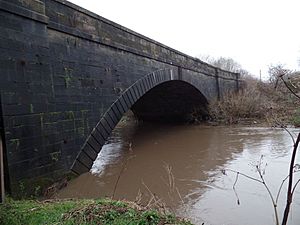River Cart Aqueduct facts for kids
Quick facts for kids River Cart Aqueduct |
|
|---|---|
 |
|
| Coordinates | 55°50′24″N 4°24′23″W / 55.839986°N 4.406396°W |
| Carries | Paisley Canal Line |
| Crosses | River Cart |
| Heritage status | Category A |
| Characteristics | |
| Material | Stone |
| Height | 30 feet (9.1 m) |
| Number of spans | 1 |
| History | |
| Engineering design by | John Rennie and Thomas Telford |
| Opened | 1811 (opened in 1885 as railway bridge) |
The River Cart Aqueduct, also called the Blackhall Bridge, is a special bridge in Paisley, Renfrewshire, Scotland. It started as an aqueduct, which is like a water bridge that carries a canal. It helped the Glasgow, Paisley and Johnstone Canal cross over the White Cart Water.
The aqueduct opened in 1811. Later, in 1881, the canal closed down. So, the aqueduct was changed into a railway bridge in 1885. Now, it carries the Paisley Canal Line, which is a train track. This bridge is very important and is listed as a Category A listed building by Historic Environment Scotland. This means it's a building of great national importance.
Contents
How the Aqueduct Was Built
When Was It Constructed?
The building of the River Cart Aqueduct happened between 1808 and 1810. It was officially opened in 1811. Its main job was to carry the Glasgow, Paisley and Johnstone Canal over the river.
Who Designed the Aqueduct?
Two famous engineers, John Rennie and Thomas Telford, helped design this amazing structure. A builder named John Simpson was in charge of the construction. Building the aqueduct cost £5,440, which was a lot of money back then!
From Canal to Railway
The canal that the aqueduct carried stopped being used in 1881. After that, the aqueduct was changed. It became part of the Paisley Canal Line, which is a train route. The railway opened in 1885, using the old aqueduct as a bridge for trains.
What Does the Aqueduct Look Like?
Main Features of the Bridge
The River Cart Aqueduct is made from freestone masonry, which is a type of stone. It has one large arch that spans about 88 feet and 6 inches (about 27 meters). The bridge stands about 30 feet (about 9 meters) above the water.
How Big Is It?
This bridge is thought to be the longest stone aqueduct built during the canal age in Britain. It is also one of the first bridges in the world to carry a public railway. When it was changed for the railway, it was made wider. This was so it could carry two train tracks instead of just one. The train line crosses the bridge at a slight angle because the canal's sharp curve was made smoother for the trains.
How It Was Used Before
When the aqueduct carried the canal, it was only wide enough for one boat at a time. This meant that boats sometimes had to wait for another boat to pass before they could cross.
Images for kids


